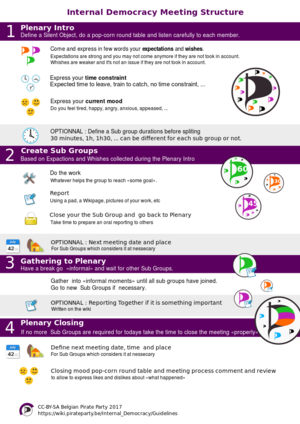Internal Democracy/Guidelines: Difference between revisions
Jump to navigation
Jump to search
m (Reverted edits by Tierce (talk) to last revision by Jan Rainald) |
(visual for the meeting guidelines) |
||
| Line 5: | Line 5: | ||
== Structure of the meeting == | == Structure of the meeting == | ||
[[File:MeetingGuideLinesVisual.svg|thumb|right|Visual for the meeting guidelines]] | |||
=== Intro ''plenary'' === | === Intro ''plenary'' === | ||
| Line 17: | Line 18: | ||
=== Body ''in subgroups'' === | === Body ''in subgroups'' === | ||
:Here people have the possibility to introduce further. | :Here people have the possibility to introduce further. | ||
| Line 38: | Line 37: | ||
## Pro's and contra's of the plenaries (intro and closing) and discussion about how to do next time | ## Pro's and contra's of the plenaries (intro and closing) and discussion about how to do next time | ||
# What do we decide for next time: venue, date, hour, general goal, proposition of subgroups. | # What do we decide for next time: venue, date, hour, general goal, proposition of subgroups. | ||
== Moderation (experimental) == | == Moderation (experimental) == | ||
Revision as of 11:48, 18 October 2017
Introduction
The following guidelines are a work-in-progress document produced by the Internal Democracy group. They are experimented at each of the group's meeting.
Structure of the meeting
Intro plenary
- There is a short roundtable where:
- Everyone tells at what time they want/need to leave.
- Everyone says how they feel/what their mood is (1-2 words)
- Everyone tells about their expectation(s) and/or wish(es)
- Expectations (what do they want to do/talk about/see happening). We defined expectations as things need to be done/happen or else you wouldn't want to come any more.
- Everyone tells their wishes. These are things you would like to see done/like to do, but it's not so bad if these don't happen.
- After this, subgroups are formed (3/5 people) based on wishes (what people want to do/talk about).
Body in subgroups
- Here people have the possibility to introduce further.
- Discussion/work to be done.
- Evaluation: this should be done every time someone intends to leave. This consists of a popcorn roundtable where:
- Everyone says how they feel (see Intro)
- Everyone can say what they thought the pro and contra of the process were. Discussion on how the process can be improved can be done here.
Closing plenary
- Each subgroup reports orally his conclusion/decisions to the whole group
- Everyone needs to make sure they understand the conclusions, but there is no further discussion here.
- When everyone is sure they understand, everyone can say if they agree/disagree. If everyone agrees, this is a decision. If this is not the case, this can be discussed further in a next meeting. There is no discussion here.
- If there is no unanimity: decide for a next submeeting involving people disagreeing.
- Evaluation (30 minutes before the end time), popcorn roundtable where:
- Everyone says how they feel (1-2 words)
- Pro's and contra's of the plenaries (intro and closing) and discussion about how to do next time
- What do we decide for next time: venue, date, hour, general goal, proposition of subgroups.
Moderation (experimental)
Define a silent object (an empty bottle, a napkin, a saltshaker, ...) anything accessible by every members of the assembly.
It can be taken by anyone who needs all the group to remain silent until the silent object is released after a few seconds (to one or two minutes maximum).
The object become available again and the discussions can continue.
If more silent seems to be necessary, maybe it is the moment to have a break.
Listen, listen, listen ... and listen. Speak is not always necessary.
Reporting (under construction)
It's an important point which have to be done by sub groups (because the have to report to the plenary) and by the plenary (intro & closing).
- Purpose
- Make participation of others possible.
- Provides to others with the means necessary to reach a concensus, a decision and/or an action.
- Levels
- Personal.
- For the group (the active members of a project).
- For everyone (the rest of the world).
- Content
- Have to be discussed and defined but probably related to the Five Ws (what, who where, when, why +how).
- Can be related to «what is the result of the meeting».
- Can be related to «how we provide the result».
- Media
- Oral, we can count on our listening, collective memory, and group dynamics.
- Written, if every members are unavailable, the written text is available.
- We can use the wiki because disregarding the fact that it seems to be complicated for the untrained users, it is a plateform on which we count because; it's FOSS, it's public, it's transparent, it does not forget (create, edit, delete, move).
